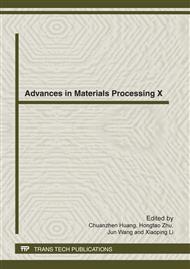p.679
p.685
p.690
p.696
p.702
p.709
p.715
p.721
p.727
The Simulation Research of Nano-Indentation Based on the Molecular Dynamics
Abstract:
The work in the optimization of the simulation of nanoindentation based on the molecular dynamics was mainly introduced in this paper. One optimization method, freeze atoms method was proposed according to the characteristics of nanoindentation process itself, then did the simulation calculation through the use of freeze atoms method and the traditional calculation method, It was found that the difference between simulation results and experimental results of hardness decreased gradually with enlarge the scale of molecular dynamics simulation (with increase of the indentation depth), from 32.39% of 5nm decreased to 14.6% of 25nm. By comparison, it was found that the optimized algorithm could improve the efficiency of simulation in large-scale molecular dynamics simulation., confirmed the correctness and effectiveness of freeze atoms method.
Info:
Periodical:
Pages:
702-706
Citation:
Online since:
April 2012
Authors:
Keywords:
Price:
Сopyright:
© 2012 Trans Tech Publications Ltd. All Rights Reserved
Share:
Citation:


